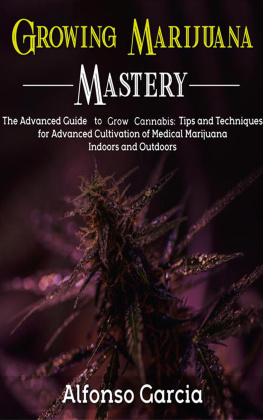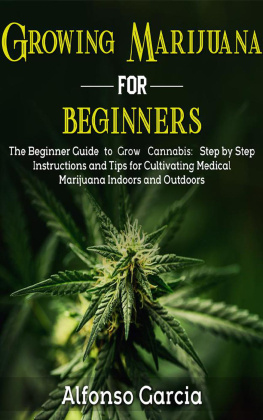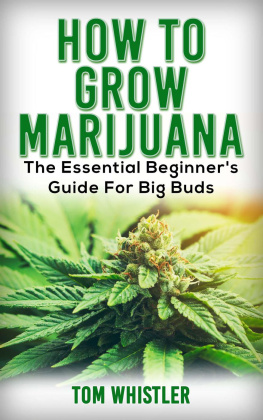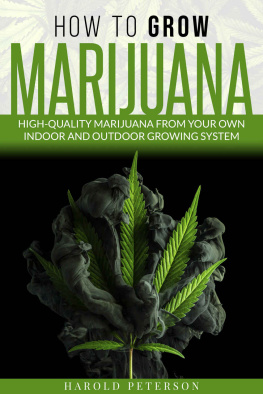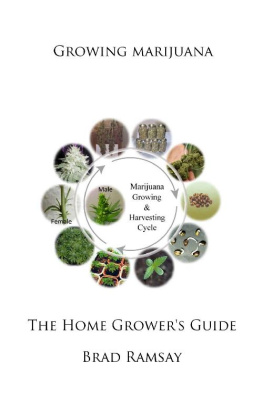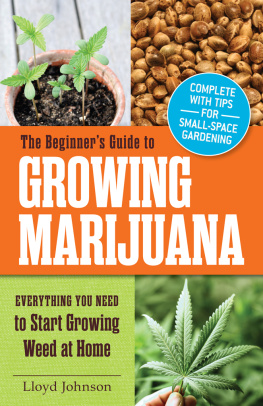HOMEGROWN
MARIJUANA
CREATE A HYDROPONIC GROWING SYSTEM IN YOUR OWN HOME
JOSHUA SHEETS

First published in 2015 by Cool Springs Press, an imprint of Quarto Publishing Group USA Inc., 400 First Avenue North, Suite 400, Minneapolis, MN 55401 USA
2015 Quarto Publishing Group USA Inc.
Text 2015 Joshua Sheets
All rights reserved. With the exception of quoting brief passages for the purposes of review, no part of this publication may be reproduced without prior written permission from the Publisher.
The information in this book is true and complete to the best of our knowledge. All recommendations are made without any guarantee on the part of the author or Publisher, who also disclaims any liability incurred in connection with the use of this data or specific details.
We recognize, further, that some words, model names, and designations mentioned herein are the property of the trademark holder. We use them for identification purposes only. This is not an official publication.
Cool Springs Press titles are also available at discounts in bulk quantity for industrial or sales-promotional use. For details write to Special Sales Manager at Quarto Publishing Group USA Inc., 400 First Avenue North, Suite 400, Minneapolis, MN 55401 USA.
To find out more about our books, visit us online at www.coolspringspress.com.
Digital edition: 978-1-6278-8651-2
Softcover edition: 978-1-5918-6910-8
Library of Congress Cataloging-in-Publication Data
Sheets, Joshua, 1981- author.
Homegrown marijuana : create a hydroponic growing system in your own home / Joshua Sheets.
pages cm
Includes index.
ISBN 978-1-59186-910-8 (sc)
1. Cannabis. 2. Marijuana. 3. Hydroponics. I. Title.
SB295.C35S48 2015
633.79--dc23
2015012204
Acquisitions Editor: Billie Brownell
Project Manager: Jordan Wiklund
Art Director: Cindy Samargia Laun
Book Design: Laurie Young
Photography: John Barber, Rau+Barber
Illustration: Shannon Rahkola
Dedication and Acknowledgments
I would like to thank my family for sticking with me as I gained the knowledge and experience necessary to write this book. And to my partner in crime, James Durham, for being my best and brightest pupil, as well as my best friend, thank you. Thanks to Drew Kepner and to the Rexious family, particularly Kern Rexious. Thanks to Ed Ansorg and Vicki Buckman from Peninsula College. And to many others: Diane and Paul Williamson, the original small town crew, Jared from Rainier Acres, Mike Flieshman and Mike Tullis, Jack Herer, Jeremy Garretson, Lyle Bing, Christopher Estes, D Haney King, Joe Fry, Todd Blogette, Josh Ramsey, Angelo Lumbardini, Armando Reed, and Carl and Connie Durham. And last, an acknowledgment of all the guys locked up in Washington DOC for cannabis-related charges and all the inmates participating in the horticulture program.
This book is dedicated to everyone, anywhere, who grows cannabis to treat themselves, grows it to help people, or any combination of the two.
Contents
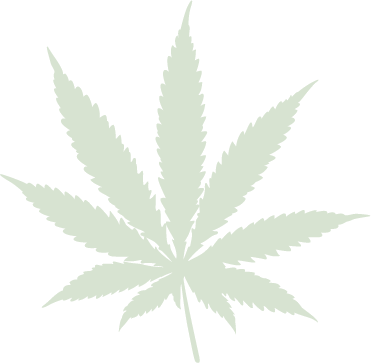
CHAPTER 1
Getting Started on a Home-Based System
If you plan to grow more than one or two plants at home, it usually makes the most sense to construct a self-contained grow room where you can control the growing environment precisely.
T he story of cannabis is practically as old as modern culture. It was described in a Chinese medical compendium considered to date from 2737 BC. Its use spread from China to India and then to North Africa and reached Europe at least as early as AD 500. A major crop in colonial North America, cannabis (hemp) was grown as a source of fiber. Hemp has made a comeback as an agricultural crop, with nearly $500 million in retail sales of hemp products in the United States in 2012.
Its use as an intoxicant was also commonplace from the 1850s to the 1930s. A campaign conducted in the 1930s by the United States Federal Bureau of Narcotics sought to portray marijuana as a powerful, addictive substance that would lead users into narcotics addiction. In the 1950s it was an accessory of the Beat Generation; in the 1960s it was used by college students and hippies and became a symbol of rebellion against authority. However, medicinally it was and is prescribed for various conditions including labor pains, nausea, and rheumatism.
The Controlled Substances Act of 1970 classified marijuana, along with heroin and LSD, as a Schedule I drug. Most marijuana at that time came from Mexico, but in 1975 the Mexican government agreed to eradicate the Mexican crop by spraying it with the herbicide paraquat, raising fears of toxic side effects. Colombia then became the main supplier.
The zero tolerance climate of the Reagan and Bush administrations (19811993) resulted in passage of strict laws and mandatory sentences for possession of marijuana as well as in heightened vigilance against smuggling at the southern borders. The War on Drugs brought with it a shift from reliance on imported supplies to domestic cultivation (particularly in Hawaii and California). Beginning in 1982, the Drug Enforcement Administration (DEA) increased attention to marijuana farms in the United States, and there was a shift toward the indoor growing of plants specially developed for small size and high yield.
After more than a decade of decreasing use, marijuana smoking began an upward trend once more in the early 1990s, but by the end of the decade this upswing had leveled off well below former peaks of use. California legalized medicinal marijuana with the passage of Proposition 215 in the mid-90s, followed by Washington and other states. In 2012, Washington and Colorado legalized separate systems for medical and recreational use. Internationally, Spain and a handful of other countries have taken a tolerant stance toward legal cannabis consumption. This link has a chart of marijuana legislation: www.ncsl.org/research/health/state-medical-marijuana-laws.aspx.
My Story
When I was thirteen, I began having symptoms of a rare neurological disorder. After two years of being misdiagnosed repeatedly, and trying a ton of prescription drugs, I was ready to try any cure. During this period I was also a rebellious youth, as many are, and I tried smoking marijuana. I noticed an increase in the duration between episodes. The prescription drugs were expensive, they werent working, and they had awful side effects. If medical marijuana had been approved in my state, that would have been the end of the story (assuming I could have found an ample supply that was both affordable and powerful and the purveyor would sell to a fifteen-year-old). But that wasnt the case, so I took my limited knowledge of gardening and I germinated seeds I found in bags in order to grow my own cure.
My first crop took heavy losses from a local herd of deer, but I was hooked on the thrill of having the power to treat myself. The need for relief in the winter months drove me indoors; there, the botany bug really bit me. Some might say my lust for the best flower ran hand in hand with greed, but I think back on those years as something purer. Then I was arrested and sent to prison, unfortunately.
During incarceration I was given the opportunity to attend college. After graduating with a 3.98 GPA, I combined my knowledge and experience into a position as a teachers aide. Obvious holes in a hydroponics curriculum gave me a desire to write text to fill in the syllabus. That was the basis for this book.


